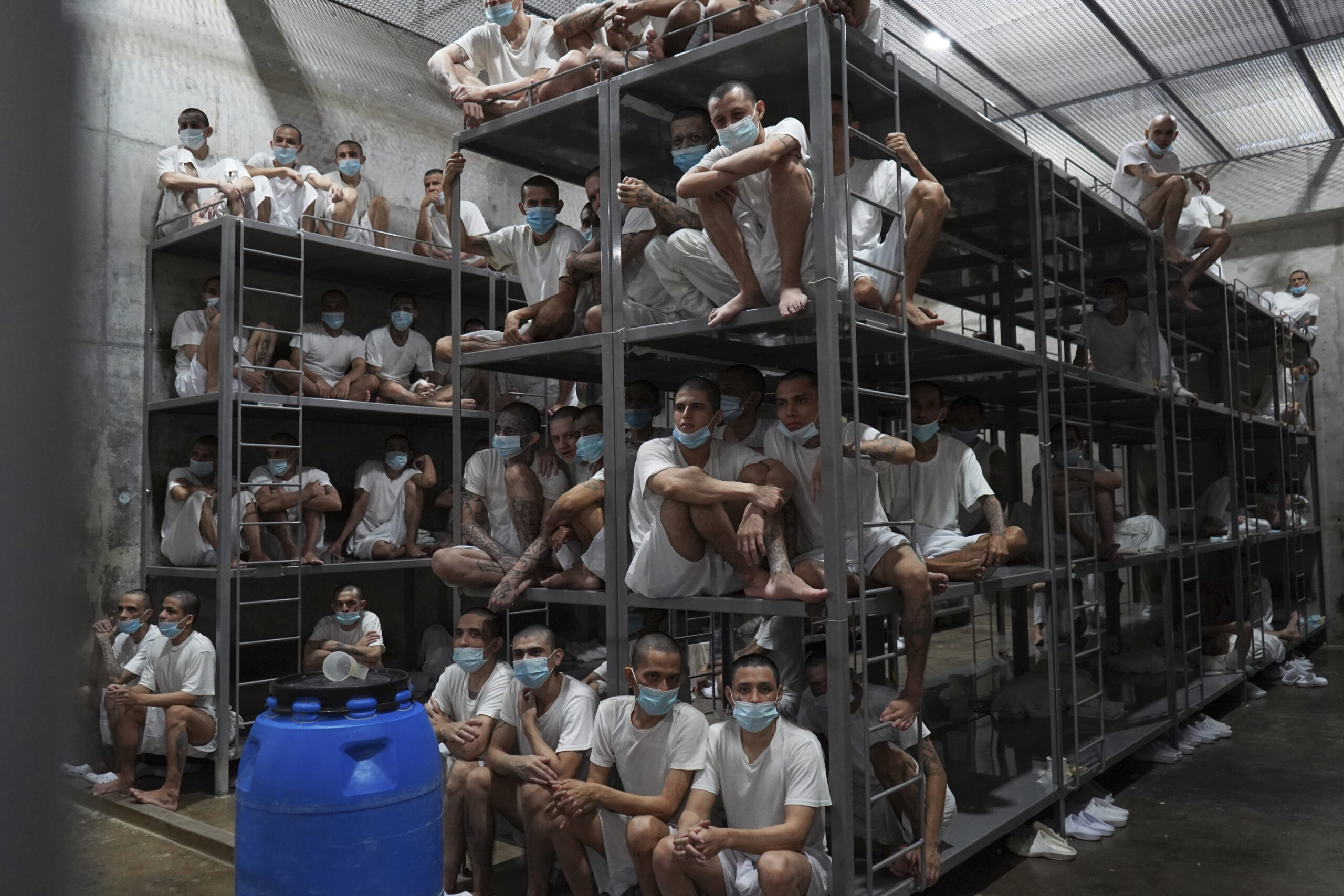In the aftermath of the Sept. 11, 2001, terrorist attacks, the George W. Bush administration detained suspected terrorists and alleged “enemy combatants” in Guantanamo Bay, setting off fierce debates over the rule of law and, eventually, leading to a new American legal framework that provided at least some rights to those detained by the U.S. government during war.
The Trump administration now appears ready to manipulate that framework to summarily deport untold numbers of people to El Salvador, in a time of peace, with little to no meaningful legal process. President Donald Trump has invoked an 18th century wartime powers law, the Alien Enemies Act, to try to accomplish this, under the claim that we are engaged in armed hostilities — within our borders, no less — with the government of Venezuela, the Venezuelan gang Tren de Aragua or both.
Already it has become clear that the government’s decision has been seriously flawed: The administration last week conceded that it erroneously deported a man from Maryland to El Salvador despite a court order allowing him to stay in the U.S. The administration also claimed that it was unable to do anything about it, but on Thursday, the Supreme Court (in an unsigned order) directed the administration to “facilitate” his release. The opinion explicitly declined to order the administration to “effectuate” his release, and that distinction may unfortunately come to matter. But it was a notable sign that the court isn’t prepared to just rubber stamp anything the administration pushes on this matter.
Meanwhile, the government has provided virtually no meaningful public information about the undocumented immigrants alleged to be Venezuelan gang members whisked off weeks ago, though according to CBS News’ 60 Minutes, the “overwhelming majority have no apparent criminal convictions or even criminal charges.”
Beyond the specifics of implementation, the administration’s maneuvering appears to represent a concerted effort to evade longstanding American law by intentionally sending people to a legal black hole with no process, no rights and no recourse.
Whether or not this will stand now largely depends on the Supreme Court, which has yet to rule on key aspects of the saga and has sent some potentially conflicting signals. Despite the court’s brushback to Trump on Thursday, five Republican justices on Monday gave the Trump administration a considerable victory in its effort by allowing it to continue detaining people under the AEA and making it more difficult for them to challenge their deportations. Most notably, the justices also signaled that they may facilitate some — if not all, as we learned from the decision on Thursday — of the administration’s legal machinations.
In a strange twist, the Guantanamo cases already provided some clues about how the current court might approach these issues. That is because the justices that comprised the majority in the key cases establishing new law and basic rights for the detainees are all gone. The current Republican appointees on the court who were already sitting or were seated during that period — John Roberts, Clarence Thomas and Samuel Alito — all dissented at the time, and along with Neil Gorsuch and Brett Kavanaugh, they comprised the majority in Monday’s decision. Indeed, in a concurring opinion, Justice Brett Kavanaugh explicitly referred to “transfers of Guantanamo and other wartime detainees” to support the majority’s ruling.
There may be years of bitter legal fights to come, but the Guantanamo Bay comparisons were already obvious to those familiar with that episode in history.
“In both cases, the U.S. is labeling people ‘enemies’ with little or no process, and then shipping them offshore,” David Cole, a Georgetown law professor who was perhaps the most prominent and influential critic of the detentions at Guantanamo Bay and, until last year, the ACLU’s National Legal Director, told me before the Supreme Court’s decision on Monday. “And in both cases the U.S. is claiming that because they are offshore, they have no rights.”
There are also obvious and highly significant differences. “The biggest one,” Cole observed, “is that al Qaeda actually attacked us and we were in an actual and extended armed conflict with them. By contrast, nobody even heard of the Venezuelan gang until Trump declared, falsely, that they had ‘invaded’ us, and we have never been in an armed conflict with them.”
On top of that, “the individuals rounded up by Trump were all here in the U.S. and therefore have full due process rights,” and “as bad as [Guantanamo] was, the prison in El Salvador we are sending individuals to is even worse.”
If you are not of a certain age, it can be hard to wrap your head around the political and legal climate after 9/11. Nearly 3,000 Americans had been killed in the terrorist attacks, and there was widespread fear that more violence could follow.
The Bush administration seized on that backdrop and took extraordinary legal positions from the start — moves that in broad strokes presaged the Trump administration’s positions today. The government argued at the time that American courts lacked jurisdiction to review the legality of the detentions at Guantanamo, and that the president was free to ignore both national and international law governing the humanitarian treatment of detainees.
A series of scandals and unprecedented legal clashes followed. There were shocking revelations of prisoner abuse by American soldiers at a prison in Iraq and well-documented uses of torture by CIA officials.
In the years following 9/11, the Supreme Court addressed novel questions concerning the government’s wartime detention powers. A majority of justices eventually concluded that the detainees at Guantanamo were entitled to challenge their detentions in U.S. courts through habeas proceedings, which are legal cases that allow people to contest their detention or imprisonment by the government as unlawful. After Bush left office and Barack Obama took over, the government passed a broad ban on torture.
Trump’s machinations appear to have been designed to circumvent such legal constraints and go further than Guantanamo Bay ever did by detaining U.S. residents in a time of peace and ultimately sending them to a foreign country.
And the Supreme Court may ultimately be willing to enable him.
In the decision on Monday, five of the Republican appointees on the court lifted a temporary restraining order issued by a judge in Washington that blocked the administration from deporting additional people under the Alien Enemies Act pending final review of the matter. The majority held that the administration could continue rounding more people up, but that current and future detainees must be given notice and an opportunity to file for habeas relief in their district of confinement prior to being sent overseas. The administration attempted to evade court review entirely, and in that respect it failed, but it may have come out ahead in several key respects.
The majority’s opinion is perhaps most notable for what it does not say. The majority did not tip its hand on the question of whether the Alien Enemies Act can be applied here — which will need to be resolved at some point — but that omission suggests that they may be open to the idea that Trump can claim that the U.S. is “at war” with a Venezuelan gang despite the many serious factual and legal problems with that argument.
The majority also held that habeas proceedings were the detainees’ only avenue for redress and knocked out a whole set of claims brought by the plaintiffs under the Administrative Procedures Act — claims that made sense here given the fact that the administration is not apprehending people on an ad hoc basis overseas in the middle of a war, but is instead rounding people up on a systematic basis within our borders.
As for those habeas proceedings: The majority signaled that the scope of judicial review may ultimately be narrow — writing at different points that the AEA largely precludes judicial review and that judicial review “is limited.” Exactly how “limited” remains to be seen and will turn on the resolution of many outstanding questions.
The majority suggested that cases will also need to be brought on an individual basis rather than as a class-action lawsuit — which means that we may eventually see hundreds of habeas cases filed in conservative courts in Texas, where some people are currently being detained, or in whatever other government-friendly jurisdiction the administration decides to confine them in before providing them with notice that they may be deported.
There are also many highly significant procedural questions still up in the air. Among them: Are the detainees entitled to lawyers? What is the burden of proof on the government in this context to establish that someone should be deported under the law — a preponderance of the evidence, or something lower? If evidentiary hearings are required, what rules of evidence will apply? What amount of deference (if any) will be given to the administration and to individual officers’ claims against the detainees? The government appears to have used unreliable hearsay to round people up; will that evidence be admissible against the detainees?
It took years to resolve these at Guantanamo, and it was done through a patchwork of court rulings and laws passed by Congress. All of these questions may now have to be hammered out in the courts.
With the Trump administration moving so quickly and aggressively to deport people, it was practically inevitable that the administration would make a serious mistake.
Even if we were engaged in a real war — which we are not — the risk of grievous error would be obvious, and it is a lesson that should have been learned from the country’s experience with Guantanamo.
“The very fact that by the time it left office the Bush administration had released over 500 of the people it initially detained at [Guantanamo] shows that they were not all ‘enemy combatants,’ as was initially claimed,” Cole told me. “And there are credible allegations already that the Trump administration wrongly identified people here as gang members.”
Still, he said, “whether they were gang members or not, they are entitled to due process, and they are not ‘enemies’ in a declared war as the [Alien Enemies Act] would require.” The scope of the “due process” they will ultimately receive from this Supreme Court, however, remains to be seen.
The concept of “due process” can sometimes seem vague or abstract, but it is an elemental part of American law, and it is embodied in our Constitution for good reason. The availability of habeas relief — the most basic protection against wrongful detention in our legal system — is also more than a legal formality, and robust due process protections are not mere abstractions. They represent a fundamental commitment in a society that aspires to the rule of law, and they advance one of the central goals of a legitimate legal system — the idea that the law should be a civilizing instrument, not a tool to exploit for terror or brutality.
The assault on this commitment threatens everyone — even if you are an American citizen.
When this issue reaches the Supreme Court for a final resolution on the merits, the Republican appointees will face a remarkable test. Will they endorse Trump’s unprecedented legal theory and provide the executive branch with extraordinary, nearly unfettered power? They have already gone some of the way there, notwithstanding the ruling on Thursday.
Or will they learn the lessons of the post-9/11 era and of Guantanamo, and insist on robust protections to ensure that our courts retain their role in enforcing our immigration laws without needless brutality?
The ruling on Thursday was one step in the right direction. But the fact that the Trump administration originally balked at getting the erroneously deported man back — and the fact that we have to worry about whether the administration will successfully “facilitate” his release despite the fact that it paid El Salvador $6 million to house the deportees there — is cause for serious concern. The Trump administration is trying to devise a set of tools that would create a hierarchy of American residents with differing constitutional rights — a hierarchy that, despite however safe you may currently feel, you can move up or down depending on what the government decides now or in the future.




